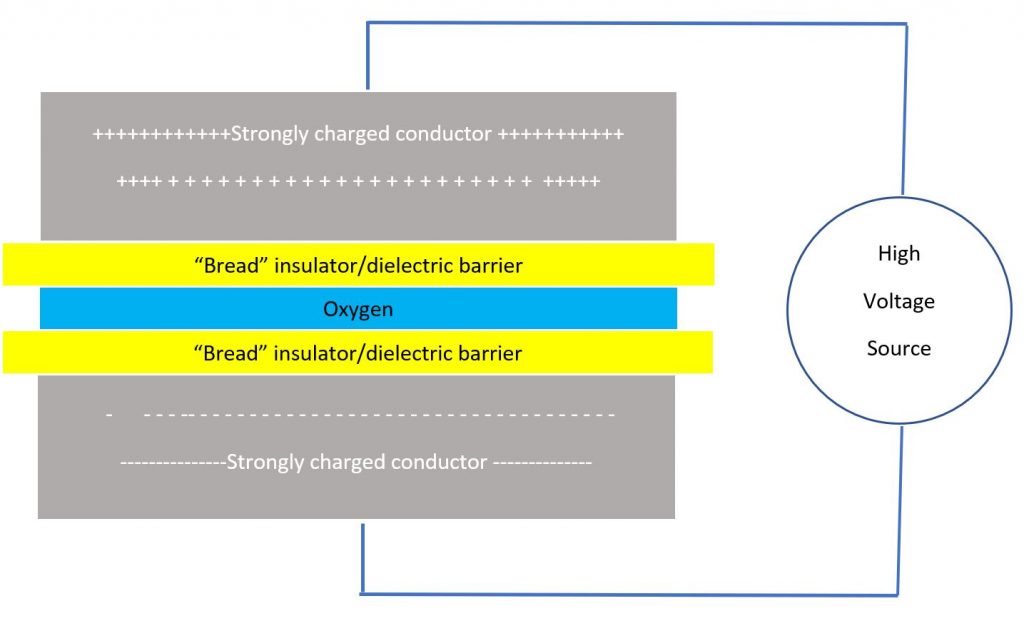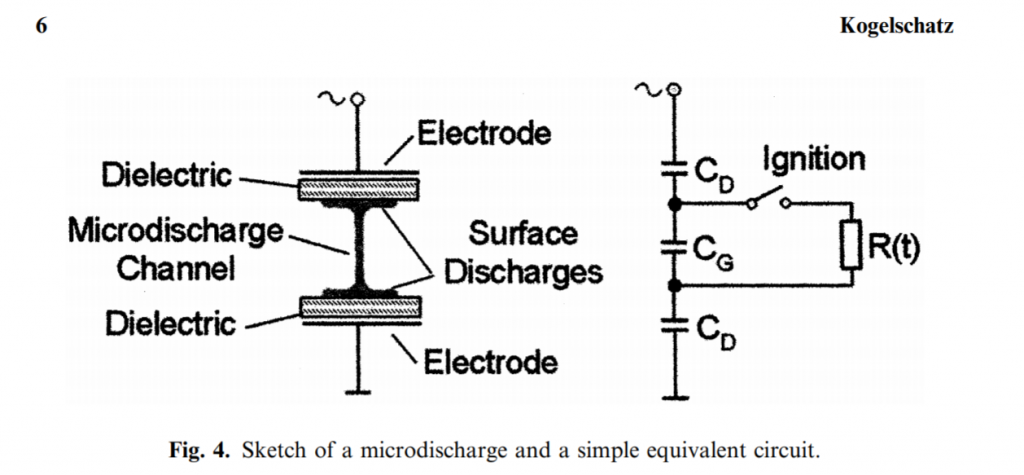
Photo by Devansh.sharma – Own work, CC BY-SA 4.0, https://commons.wikimedia.org/w/index.php?curid=36462262
A Not-So-Lazy River Circuit Analogy
Our journey to the center of an ozone generating plasma cell begins with a ride around a not-so-lazy river. Perhaps you’ve enjoyed floating in a raft around a lazy river at a hotel or water park. Picture these rafts as electrons flowing through a circuit. Moving magnetic fields are pushing electrons through the fluid media of metal atoms. They follow the circular paths of circuits like rafts floating around and around the lazy river ride. A pump continually pushes the water along.
Unlike the continuous flow in one direction of direct current (DC), alternating current continuously reverses the flow of electrons. Imagine the lazy river model constantly changing direction. The electrons first flow one way, slow, reverse, and rush the other way. The electric supply to your home goes through 60 cycles per second. Our lazy river model begins to defy imagination at this rate of change. You can think of electrons as virtually weightless, unlike all the water and rafts in a lazy river. Electrons are quite capable of reversing direction very quickly.
Energy Transfer
The flow of electrons through a wire might be apparent from the glow of a light bulb. As electrons squeeze through a resistive part of the circuit, the wire heats up transferring energy to heat and light. Other things are happening outside the wire. Hold a compass near a wire in which current is flowing, and the needle is pulled away from North. Whenever an electric current flows, a magnetic field develops around the wire. Stop the flow, and the field collapses.
Wrap this conductor into a coil, and the magnetic field is intensified. Add an iron core, and a magnet is born. A continuous flow supports a useful magnetic field, capable of pushing the rotor of a motor or the lever of a switch. Again we notice a transfer of energy, this time from electric current flow to some mechanical motion. Energy transfer doesn’t stop there.
Energy transfer is reversed in a magnetic field when the electric current stops. When current stops or reverses, the magnetic field collapses. The collapsing magnetic field gives electrons a push in the coiled conductor. This phenomena opens up the possibility of generating a flow of electrons in a second circuit that is isolated from the first circuit. It also introduces radio waves. Imagine a second lazy river next to yours. It doesn’t have a pump, so the water is still. But imagine an invisible force generated by the flowing of the first river pushing the water along in the second. Such a transfer of energy happens with the flow of electrons and is essential to ozone production within a plasma cell.
A Dam in the River: The Plasma Cell Heart
A dam in the lazy river brings the rafts to a halt, but build two Olympic sized pools on either side of the dam. Now the river continues to flow awhile even with a dam because it takes time to fill the pool. Depending on the strength of the pump, the water flows for a while as one pool gets a little deeper while the other is drawn down. If you can pump one pool much deeper than the other, a significant stress builds on the dam. Our lazy river could get exciting if the dam were to burst. We are getting closer to the center of a plasma cell.
In your mind you need to convert the Olympic sized swimming pools in our lazy river circuit to large flat pieces of metal. In the electron world, the dam between these two plates is an insulator, a material that prevents the flow of electrons. Electrons pile up on one side while they are drawn down on the other side. Electrons are the negative charge. Pulling electrons away leaves one side with deficiency of electrons: a positive charge. If the insulator were breached, a powerful surge of electrons would create a dramatic spark. It would be equivalent to the deep swimming pool emptying to the shallow one in milliseconds.
It is here at the “dam” where we discover the center of a plasma cell. When the distance between the two electrically charged plates is made smaller, the electrostatic forces between them grow exponentially. In other words, a thinner dam makes a more powerful electrostatic field. But a thin dam is also weaker and more susceptible to failure. The goal is a material that is strong and a good electrical insulator. Ceramic and quartz serve well for this purpose. But without some oxygen present in this high electrical pressure environment, we only have a capacitor and no ozone production.
We need to introduce one more element: a thin layer of oxygen as part of the “electron dam.” We can think of the dam as a sandwich of two insulators with a very thin slice of oxygen between them. When oxygen is exposed to the tremendous electrostatic forces found within this space between highly charged surfaces, the oxygen molecules are pulled apart and re-combine in highly energized forms. I would like to zoom in for a closer look at this sliver of space.
A Peak Inside the World Between Dielectric Barriers
Photographs of this space between the two insulators reveals what appears to be a mini, but intense electrical storm. We are used to thinking about lightning bolts jumping from one charged conductor to another, but in this electrostatic microcosm, the mini “bolts of lightning” are jumping from the surface of one insulator to the surface of the second insulator. In the presence of the strong electric field, the molecules within the insulator become polarized. This means that the electrons are pulled by the positive electrode toward one end of the molecule that make up the insulator. Even though electrons are unable to flow through the insulator, the polarization sets up “pools” of electrons on the surface. We call the insulating material used in in this application a “dielectric.” The type of ozone generator we are entering here is a dielectric barrier discharge (DBD) generator.
Exactly what is happening in this high electrical pressure world between dielectric barriers has been and continues to be a topic of considerable research and study. Already around 1897, John Townsend discovered that the strong electric field in the oxygen space between dielectrics initiates electron avalanches. A free electron among the oxygen atoms accelerates very quickly because it is attracted to the positively charged plate (anode). When it reaches a high enough velocity and collides with an oxygen molecule, it knocks off another electron, turning the molecule into a positively charged ion. This ion begins to move in the opposite direction toward the negatively charged plate (cathode) while the two electrons further accelerate toward the anode and collide with more oxygen molecules. As the growing electron cloud races toward the anode, it leaves a trail of positively charged ions in its wake.
This trail of ions and free electrons is conductive, and allows for a discharge of electric current through the oxygen. The discharge is the flow of electrons that has gathered on the surface of the dielectric towards the positive charge on the other side of the oxygen gap. It is this discharge of energy that breaks the oxygen molecule bonds releasing free oxygen atoms. Some re-combine with single atoms, and others combine with pairs to form highly energized ozone molecules made of three oxygen atoms. The world here at the center of an ozone generator is a stormy one swarming with surges of electrons.
DBD: A Specialized Form of Corona Discharge
The discharge is similar to a spark, but not nearly as hot. It does not result in a discharge of the electrodes. Only small areas of the inside surface of the dielectric discharge with each electron avalanche. The strong electric field induces a secondary, high voltage mini-circuit within the oxygen gap. Thousands of these discharges can be repeated as long as the voltage supplied to the anode and cathode continues to increase.
The power supply for an ozone generator alternates this electric field thousands of time each second. When the pressure (voltage) rises through the threshold that sets off electron avalanches, the discharge storm erupts. Since the electric field changes thousands of times each second, the oxygen gap experiences thousands of storms each second. The optimal frequency and voltage depends on the gap size and oxygen pressure. The electronics controlling the voltage need to be tuned to match the particular dielectric arrangement for optimal ozone production.
The benefits of setting off thousands of mini discharges in a space between insulators instead of simply allowing a spark to ark between the positive and negative electrodes are the following: 1) an arc generates so much heat that it melts most materials. Such an arc is useful for welding or plasma torches, but would destroy an ozone generator. 2) Ozone production is minimal with an arc. Most of the energy is converted to heat and the heat destroys ozone. 3) Producing many small discharges from dielectric surfaces within a strong electrical field stays cooler and yields more ozone.
This form of ozone generation is called “Dielectric Barrier Discharge” (DBD). DBD belongs to a category of corona discharge. Corona discharge was observed by ancient sailors on the masts of their ships as a flare of luminous plasma at the tips of the mast and other pointed parts of their ship when the atmosphere is highly charged. The phenomenon occurs when strong electrostatic forces concentrate at sharp points and break down air to form plasma. You can observe this phenomena with an electrostatic generator in a dark room. Many of the small ozone generators sold for home use rely on a form of corona discharge from sharp points. Higher quantities of high concentration ozone used in commercial applications often use DBD type ozone generators.
Ozone can also be produced with ultraviolet light and radiation bombardment. The ozone layer which protects earth from harmful radiation is produced by ultraviolet light with a wavelength less than 200 nm. Ultraviolet light between about 200 and 300 nm destroys ozone. The ozone layer is maintained with a balance of ozone generation and destruction with ultraviolet light. Ozone can be created in water with electrolysis. Passing an electric current through water breaks the water molecules into hydrogen and oxygen. Using specific electrodes results in oxygen combining to form ozone.
Here at Oxidation Technologies we do not build DBD plasma cells, but we rely on companies who continue to research and build quality generators for a wide range of applications. We specialize in integrating the right ozone generators into specific applications. Dissolving ozone into water requires ozone generators that make higher concentrations of ozone. Many applications can utilize low pressure or even slight vacuum to minimize the danger of ozone leaks. Sometimes controlling precise levels of low ozone concentrations can best be attained with an ultraviolet ozone generator. Whatever your application, we have the expertise to integrate the right ozone generator to your process.


Ozone: Science & Engineering The Journal of the International Ozone Association Volume 41, 2019 – Issue 1Ozone Synthesis and Decomposition in Oxygen-Fed Pulsed DBD System: Effect of Ozone Concentration, Power Density, and Residence Time Sławomir Jodzis &Tobiasz Barczyński From https://www.tandfonline.com/doi/abs/10.1080/01919512.2018.1506317>
IOP Science publication: Dielectric barrier discharges: progress on plasma sources and on the understanding of regimes and single filaments From <https://iopscience.iop.org/article/10.1088/1361-6595/aa6426>
Journal of Physics B: Atomic and Molecular Physics Electron impact dissociation in oxygen B Eliasson and U Kogelschatz Journal of Physics B: Atomic and Molecular Physics, Volume 19, Number 8
From <https://iopscience.iop.org/article/10.1088/0022-3700/19/8/018>
Free Use article from IOP Science: https://www.researchgate.net/publication/230926959_Ozone_Synthesis_From_Oxygen_in_Dielectric_Barrier_Discharges/link/56ddd42608aedf2bf0c86b95/download
Plasma Chemistry and Plasma Processing, Vol. 23, No. 1, March 2003 ( 2003) Inûited Reûiew Dielectric-barrier Discharges: Their History, Discharge Physics, and Industrial Applications Ulrich Kogelschatz1 Receiûed April 5, 2002; reûised May 7, 2002 https://www3.nd.edu/~sst/teaching/AME60637/reading/2003_PCPP_Kogelschatz_dbd_review.pdf
Very clear and graphic explanation https://www.plasma-school.org/files/lectures/2016/Guaitella16.pdf
